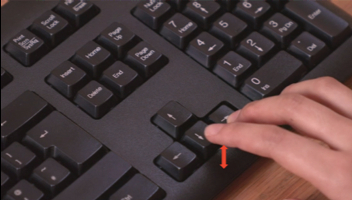Background: Bradykinesia is the defining feature of Parkinson’s disease (PD) and severity is typically assessed using the Movement Disorder Society-Unified Parkinson’s Disease Rating Scale (MDS-UPDRS). This rating scale is subject to inter- and intra-rater variability and does not provide information on the specific kinematics of motor impairment (1). As PD advances, patients frequently experience fluctuations in motor function as a consequence of treatment. Monitoring of motor complications remains reliant on history-taking, which is hindered by recall bias (2). In order to address these issues, more reliable and objective digital tests have been developed to quantify bradykinesia, including the BRadykinesia Akinesia INcoordination (BRAIN) test. The BRAIN test is an online tapping task which examines movement at the level of the elbow and shoulder, capturing proximal motor dysfunction (3) (see Figure 1). Here, a new Distal Bradykinesia Test (DBT) was developed to record motor impairment of the digits, aiming to provide a novel measure of distal bradykinesia (see Figure 2). Both tapping tests measure three parameters: kinesia score (KS) – the number of key taps over the duration of the test, akinesia time (AT) – the mean dwell time on each key in milliseconds and incoordination score (IS) – the variance of the time interval between key presses in milliseconds. Methods: 10 PD patients with motor fluctuations were recruited from clinics at the Royal London Hospital. Home visits were carried out whereby patients performed the DBT in their ‘on’ and ‘off’ states. Paired t-tests were used to compare patients’ ‘on’ and ‘off’ scores. Results: The DBT differentiated between patients’ ‘on’ and ‘off’ states using both KS (p = 0.03) and IS (p = 0.04). Whereas, the finger tapping sub-score of the gold standard MDS-UPDRS was unable to distinguish between states (p = 0.14). Furthermore, the KS parameter of the DBT showed a significant inverse correlation with total MDS-UPDRS part III (motor) scores in the ‘off’ state; a decreasing number of key taps was associated with an increase in UPDRS-III scores (Pearson’s r = -0.73, p = 0.04). Similarly, the correlation between the percentage change of KS scores from ‘off’ state to ‘on’ state against the percentage change of UPDRS-III scores also showed a strong inverse correlation (Pearson’s r = -0.85, p = 0.01). Conclusion: Preliminary evidence was obtained to show that the new DBT may be a reliable method for differentiating between when patients are ‘on’ and ‘off’ medication and monitoring motor fluctuations. The DBT was able to detect subtle changes in motor function, which were not reflected in scores derived from the MDS-UPDRS. The new DBT offers several practical advantages over current rating scales and has the potential to serve as a supplementary clinical tool in longitudinal monitoring of PD motor complications.
Future Physiology 2019 (Liverpool, UK) (2019) Proc Physiol Soc 45, PC36
Poster Communications: Developing a new web-based finger tapping test to measure distal bradykinesia in Parkinson’s disease
H. Li1, N. Akram1, C. Budu2, D. Gallagher2, A. J. Noyce1, C. Simonet1
1. Wolfson Institute of Preventive Medicine, Barts and The London School of Medicine and Dentistry, Queen Mary University of London, London, United Kingdom. 2. The Royal London Hospital, Barts Health NHS Trust, London, United Kingdom.
View other abstracts by:
Figure 1: Illustration of the BRAIN test measuring proximal bradykinesia.Alternate tapping of the ‘s' and ‘;' keys with one index finger, as fast and as accurately as possible, for 30 seconds.
Figure 2: Illustration of the new DBT measuring distal bradykinesia.Occupying the left/ right arrow key and simultaneously, repeatedly tapping the down arrow key, for 20 seconds.
Where applicable, experiments conform with Society ethical requirements.


